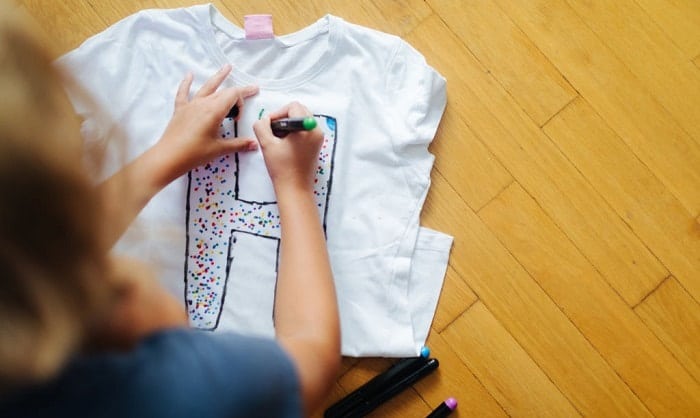There has been a rising awareness of fashion over the years because people regard it as a way of expressing themselves. Everyone wants their appearance to be fashionable and outstanding.
Yet, it isn’t economical under any circumstances to keep buying new clothes to catch up with the most recent trend. Consequently, fabric markers have become a helpful tool to personalize your style and give your t-shirts a fresher look.
So, this article will introduce you to the correct and easy method of how to use fabric markers on t-shirts. You will be decorating t-shirts with fabric markers in no time! Are you ready to design your own clothes? Let’s start with choosing the right material – fabric.
Table of Contents
Which Kind of Fabric is the Best
Although fabric markers are supposed to be usable on any materials, they work better on some types of fabric than others. Hence, you must choose the correct cloth for an astounding result.
Using fabric markers on clothes made from polyester or cotton is the best option since these kinds of fabric often absorb the ink and will not be washed out. As the amount of color bleeding is trivial, our design will remain intact even after laundry.
In addition, you should choose light-colored t-shirts because the colors will pop out. However, if your clothes are dark, there is a workaround: metallic fabric markers.
Last but not least, don’t forget to thoroughly wash and iron your t-shirt before starting this creative process so all chemicals and dust will be removed. Then, the drawing process becomes much easier and more precise.
Choosing Your Fabric Markers
Choosing the right fabric markers is an essential step in this tutorial as not all markers are the same. There are three types of fabric markers: ink-based, gel-based, and paint-based. You can choose based on your preference.
Your t-shirt marker should be permanent fabric markers, not usual permanent markers. The former consist of chemicals that make the ink bleed during the washing and drying process, which will result in unwanted effects.
Here are some highly recommended permanent fabric marker brands for your reference: Crafts 4 All, Crayola, Ohuhu, etc.
Other Things That You Will Need
Apart from your t-shirt and fabric markers, there are additional materials you need to prepare for the best outcome.
Take a piece of paper and some pencils to sketch your fabric marker t-shirt designs. If you are worried about drawing it yourself, pick your favorite designs from the internet and print them out.
Besides choosing the patterns, decide which colors you will be using and check if those markers are available, so there won’t be any discontinuity during your creative process.
Moreover, you will need a piece of cardboard or some newspaper that is the same size as your t-shirt. It helps create a flat surface, which eases your drawing process. Additionally, prepare a pencil to draw your design on the t-shirt.
You also need an iron and a piece of freezer or wax paper to set the colors after your drawing is complete.
Once you have had all the tools ready, it’s time to get to work!
Seven Simple Steps on How to Use Fabric Markers on T-Shirts
Step 1: Lay your t-shirt on a flat and smooth surface, facing whichever side you want to decorate towards you.
Step 2: Put the cardboard inside the prepared t-shirt, between the fabric layers. It will secure your t-shirt in place and prevent the marker ink from penetrating through the fabric to the other side.
Step 3: Place your design under the fabric and above the cardboard so that your design is still visible through the fabric.
Step 4: Outline your design using a pencil and closely trace the sketch you have just put underneath the cloth.
Step 5: Overlap the outline again with your fabric markers.
Step 6: Complete your t-shirt by using your markers to fill in the rest of your design.
Step 7: Let it air dry completely according to the instructions on the marker packaging and remove the cardboard as well as the sketch from inside your t-shirt.
Setting the Colors
Proceed through this step with EXTREME CAUTION since it requires a lot of heat. You might burn yourself if not careful. Children should ask their parents for support during this step.
Once your t-shirt is dry, set your iron heat to a cotton setting, which is approximately 200℃ or 400℉. Place the wax paper or freezer paper on top of your design and make sure you cover your design entirely. Otherwise, you risk burning the ink with your iron.
Wait until your iron heats up to the correct temperature. Then run your iron all over your design for a couple of minutes. If you don’t have an iron, use your drying machine.
Put your t-shirts into the machine and set it at high temperature. Let the machine do its work and take your t-shirts out after thirty minutes.
There you have it, a brand new personalized masterpiece using just fabric markers. Please continue reading to learn how you can preserve your t-shirts after being painted.
Washing Your T-shirts After Drawing on Them
Of course, you don’t want to waste your time and effort, and all your designs to become a mess after the laundry, right? Well, there are two small tips to protect your drawings from being washed out by laundry detergents.
The first tip I want to share is to separate your decorated t-shirts with other clothes when washing them for the first few times to assure that the bleeding colors won’t dye other clothes.
Secondly, in the first three times of laundry, use cold water to wash your decorated t-shirts instead of warm water. High-temperature water will dissolve the marker ink and lead to ink bleeding.
After that, you can either air-dry your clothes or use the drying machine, and show your t-shirt off to the world!
Conclusion
Without purchasing expensive new t-shirts, you can now decorate your own ones for special occasions with recycled old t-shirts and some fabric markers. It is even better if you can add your loved ones’ names to the shirts and give them as a present.
So, the tutorial on how to use fabric markers on t-shirts is over. I hope you have created some gorgeous and unique designs for your clothes. Let me know what you think in the comment section, and please share this article with other people.

I am a former art teacher, so it is evident to me the importance of art in educating the new generation. We also want to help parents who plan to teach their children and desire the best tools and tips for them.


